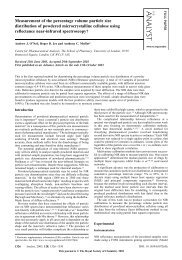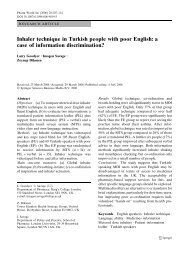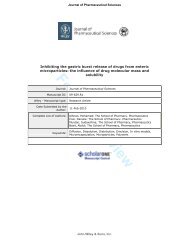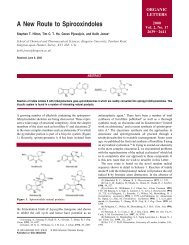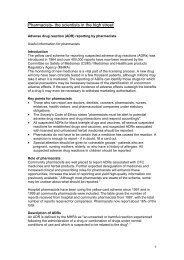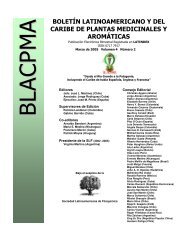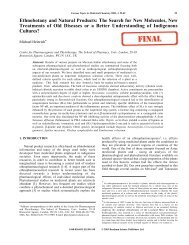SynArfGEF is a guanine nucleotide exchange ... - Pharmacy Eprints
SynArfGEF is a guanine nucleotide exchange ... - Pharmacy Eprints
SynArfGEF is a guanine nucleotide exchange ... - Pharmacy Eprints
You also want an ePaper? Increase the reach of your titles
YUMPU automatically turns print PDFs into web optimized ePapers that Google loves.
Figure 4. Immunoh<strong>is</strong>tochemical localization of synArfGEF in the cerebellum and spinal cord (A-J)<br />
Localization of synArfGEF in the cerebellar cortex (Cb). A sagittal section of the adult mouse<br />
cerebellar cortex (Cb) was immunostained for synArfGEF (B, E, H) and gephyrin (C), GABAAR α1<br />
subunit (F), or GluA2 subunit (I). Note that immunolabeling of synArfGEF in the cell bodies of<br />
Purkinje cells, basket cells (arrowhead), stellate cells and Golgi cells (arrows) as well as dendrites<br />
of Purkinje cells in the molecular layer (Mo). Also note the colocalization of synArfGEF with<br />
gephyrin and GABAAR α1 subunit but not GluA2 subunit in the molecular layer. Gr, granular layer;<br />
PC, Purkinje cell layer. (K-Q) Localization of synArfGEF in spinal motoneurons (SM). Coronal<br />
sections of the spinal cord were immunostained for synArfGEF (K), gephyrin (L) and glycine<br />
receptor α subunit (M) or with synArfGEF (O) and VGAT (P). Note the colocalization of synArfGEF,<br />
gephyrin and glycine receptor α subunit along the cell body/dendritic shafts and the close<br />
apposition of synArfGEF to VGAT. Scale bar, 20 µm in A; 5 µm in D, G, J, N and Q.<br />
Figure 5. Subcellular localization of synArfGEF by immunoelectron microscopy using the silver-<br />
enhanced immunogold method Note the accumulation of immunogold particles for synArfGEF at<br />
postsynaptic specializations of symmetric synapses of the dendritic shafts of an olfactory mitral cell<br />
in the external plexiform layer (A), a Purkinje cell in the molecular layer (B), and a spinal<br />
motoneuron (C). Note the absence of immunolabeling at asymmetric synapses (arrows). Scale<br />
bars, 200 nm.<br />
Figure 6. Interaction of synArfGEF with utrophin/dystrophin (A) Schematic representation of the<br />
domain structures of utrophin and dystrophin and the protein fragments used in the yeast two-<br />
hybrid assays. (B) Two-hybrid assays. The yeast strain MaV203 was transformed with the<br />
indicated combinations of constructs and plated onto synthetic complete medium lacking leucine<br />
and tryptophan: LT(-), or leucine, tryptophan, h<strong>is</strong>tidine and uracil: LTHU(-). Interactions were<br />
assessed by β-galactosidase activity (β-gal) and prototrophy for h<strong>is</strong>tidine and uracil. Note the<br />
interaction of synArfGEF with utrophin fragments 2653-3429, 2691-3429, 2691-3111, 2691-3058,<br />
and dystrophin fragment 2937-3685. (C, D) Pull down assays. Lysates from COS-7 cells<br />
transfected with pCAGGS-FLAG-synArfGEF (C) and mouse brains (D) were subjected to pull<br />
down assays with the indicated GST fusion proteins that were conjugated with glutathione-<br />
Sepharose 4B. The precipitates were washed with the lys<strong>is</strong> buffer containing 150 mM or 300 mM<br />
NaCl and subjected to Western blot analys<strong>is</strong> with anti-FLAG IgG (C) or anti-synArfGEF IgG (D).<br />
Figure 7. Interaction of synArfGEF with utrophin via a PPPPY motif. (A) Sequence alignment of the<br />
consensus PPPPY motif required for binding to WW domains, proline-rich sequence of the C-<br />
terminal region of synArfGEF and the mutant (PPPPY→PPAPA). (B) Two-hybrid assays. The<br />
yeast strain MaV203 was transformed with the indicated combinations of constructs and plated<br />
onto synthetic complete medium lacking leucine and tryptophan: LT(-) or leucine, tryptophan,



